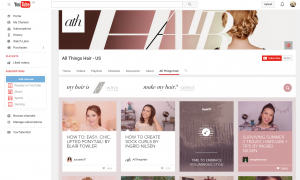Marketers are constantly looking to put out content that is engaging and creative. It is through the content that stands out from the crowd, the content that provides an extra value, and content that is unique that truly engages consumers. When brands start conversations that are past promoting its products and services, that is when not only consumers but any one is able to relate to the brand. Yes, beautiful videos and gorgeous ads can make the trick, but a marketer knows that there is so many hours in a day, and soon enough, designing and creating the content becomes unrealistic. Therefore, marketers often get creative and start looking for help elsewhere.
 Unilever, has done a great job generating content through crowdsourcing. It’s YouTube channel All Things Hair is an aggregation of hair care how-to videos that are created primarily by bloggers. As Unilever syndicates the bloggers content into a go-to channel, Unilever not only positions itself as a central part of the conversation but is also able to drive traffic from, to and between the bloggers and their channel. Most importantly, Unilever alleviates from the need to create all the videos and tutorials themselves, while also promoting advocates that most likely also use their products. Creating a sense of community and care with its consumers and the wider audience on YouTube.
Unilever, has done a great job generating content through crowdsourcing. It’s YouTube channel All Things Hair is an aggregation of hair care how-to videos that are created primarily by bloggers. As Unilever syndicates the bloggers content into a go-to channel, Unilever not only positions itself as a central part of the conversation but is also able to drive traffic from, to and between the bloggers and their channel. Most importantly, Unilever alleviates from the need to create all the videos and tutorials themselves, while also promoting advocates that most likely also use their products. Creating a sense of community and care with its consumers and the wider audience on YouTube.
Further Reads:
– 5 Ways Content Marketing Improves Your Content Marketing
– 5 Reason for Crowdsourcing Content
 Bell should provide a great example regarding how to utilize these review platforms – to stay away from them. An alleged attempt to raise the corporate apps’ review by “encouraging” employees to leave positive reviews. Although this practices can sometimes allegedly succeed, Bell reviews showed a contrasting message as employees left stellar reviews, but customers only displayed dissatisfaction with the apps. These led to a $1.25 million CAD fine.
Bell should provide a great example regarding how to utilize these review platforms – to stay away from them. An alleged attempt to raise the corporate apps’ review by “encouraging” employees to leave positive reviews. Although this practices can sometimes allegedly succeed, Bell reviews showed a contrasting message as employees left stellar reviews, but customers only displayed dissatisfaction with the apps. These led to a $1.25 million CAD fine. Facebook has been working on a new way to advertise to customers in a way that customers want to be engaged with – through an app-like experience! These new format consist of a normal news feed ad that once clicked on, it leads to a personalized blank canvas for marketers to create compelling experiences to customers.
Facebook has been working on a new way to advertise to customers in a way that customers want to be engaged with – through an app-like experience! These new format consist of a normal news feed ad that once clicked on, it leads to a personalized blank canvas for marketers to create compelling experiences to customers. TELUS, however, has been hard at work in changing this stigma. Through a campaign called “Expect More” developed by The & Partnership, TELUS is emphasizing that customers should not be compliant with what the market is offering and should expect more from their telecommunication provides. The “Expect More” campaign that seeks to encourage better customer service is not a recent strategy to the company. TELUS’ culture centers heavily on providing the best customer experience, which has been an internal strategy coined “Customer First” that took place five years ago.
TELUS, however, has been hard at work in changing this stigma. Through a campaign called “Expect More” developed by The & Partnership, TELUS is emphasizing that customers should not be compliant with what the market is offering and should expect more from their telecommunication provides. The “Expect More” campaign that seeks to encourage better customer service is not a recent strategy to the company. TELUS’ culture centers heavily on providing the best customer experience, which has been an internal strategy coined “Customer First” that took place five years ago.